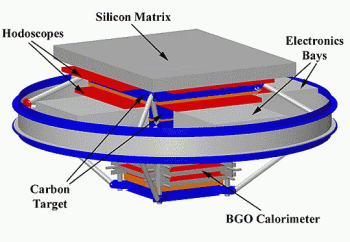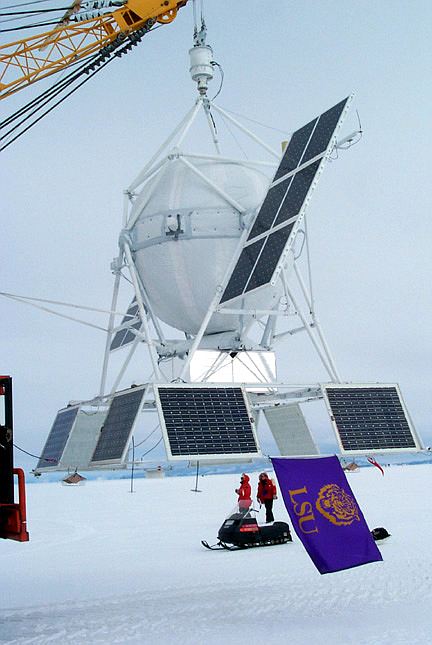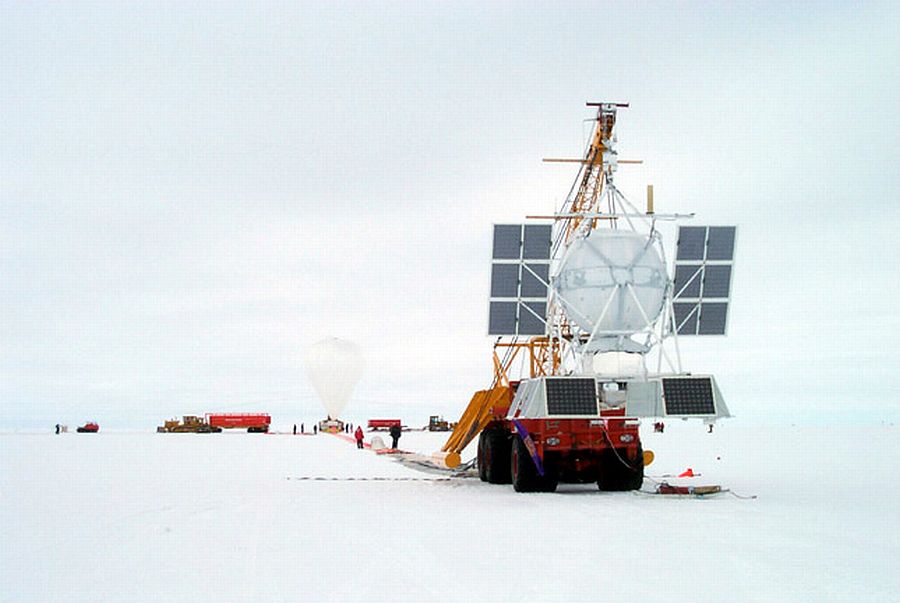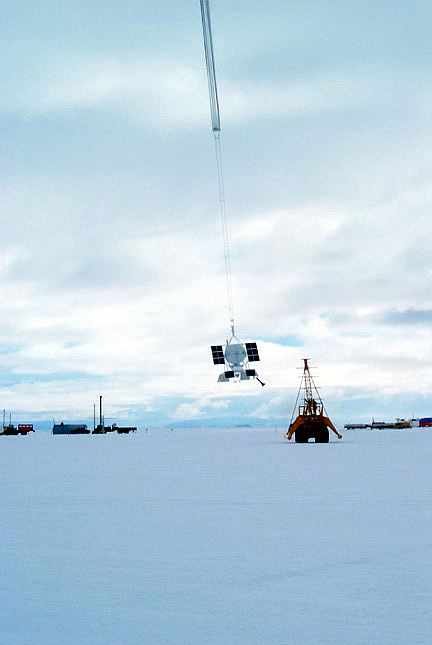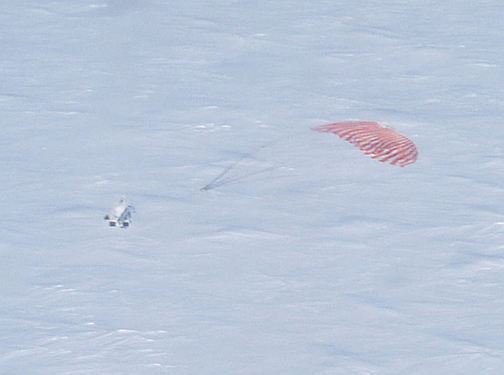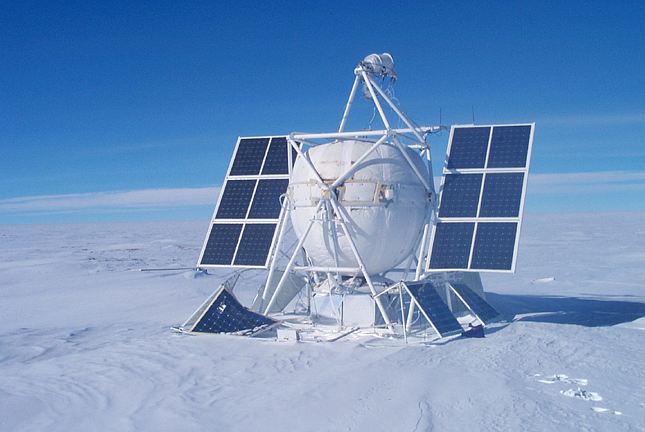Purpose of the flight and payload description
Cosmic rays are the only sample of matter from distant regions of the galaxy, and possibly elsewhere in the Universe, that can be directly observed by space experiments in the Solar System. This high energy matter consists of atomic nuclei that travel at speeds very close to the speed of light and includes electrons, the natural elements from Hydrogen and Helium to Iron and beyond as well as anti-matter in the form of positrons and anti-protons.
ATIC experiment was designed to measure the energy spectrum of individual cosmic ray elements in order to study the validity of the model that predicts that cosmic rays gain their very high energy as the result of supernova explosion shock waves traveling through interstellar gas. Several goals on regard this objective are for example to obtain energy spectra for individual elements of a broad energy range with a single instrument; to discover 'breaks' or 'bends' in the spectra, to measure the energy dependence of the H/He ratio as well determine the spectral differences between elements and obtain the composition of the cosmic ray matter.
To achieve its scientific objectives, the ATIC experiment must be capable of measuring the incident cosmic ray charge and energy over an energy range of 50 GeV to >100 TeV. A schematic of the instrument, can be seen at left (Click to enlarge).
The instrument is based on the technique of ionization calorimetry, the most practical method of energy determination for cosmic ray nuclei from H to Fe over the target energy range. The fully active ATIC calorimeter is composed of 10 layers of Bismuth Germanate (BGO) scintillating crystals and is located on the bottom of the instrument. Above the calorimeter is the target section consisting of three plastic scintillator strip hodoscopes to define the instrument aperture and provide redundant charge and trajectory measurements, as well as layers of inert carbon (between hodoscopes) to provide a volume for the incident particles to interact.
On the top of the detector stack is the highly segmented silicon matrix detector that provides an accurate measure of the incident particle charge even in the presence of shower particles backscattered from the calorimeter. Surrounding the detector stack, electronics bays hold the flight computers, readout electronics, power system boards and other instrument electronics. Finally, on each of the four corners three struts transfer the loads of the experiment through the pressure vessel ring to an external structure that attaches to the balloon.
The total weight of ATIC is about 1,500 kg (3,300 lbs), the total power consumed is less than 350 Watts (including power conversion efficiency), and the payload is designed to be quickly field stripped under Antarctic conditions.
Details of the balloon flight

Balloon launched on: 12/28/2000 at 4:28 utc
Launch site: Williams Field, McMurdo Station, Antarctica
Balloon launched by: National Scientific Balloon Facility (NSBF)
Balloon manufacturer/size/composition: Zero Pressure Balloon 800.000 m3 - SF3-29.47-.8/.8/.8-NA
Balloon serial number: W29.47-2X-53
Flight identification number: 493N
End of flight (L for landing time, W for last contact, otherwise termination time): 1/13/2001 at 1:51 utc
Balloon flight duration (F: time at float only, otherwise total flight time in d:days / h:hours or m:minutes - ): 17 d
Landing site: At 75º 30' S 154º 5' E, Antarctica
Payload weight: 3470 lbs
Overall weight: 4935 lbs
The balloon was launched by dynamic method assisted by launch vehicle after several cancellations due to bad weather on December 28th, 2000, at 4:25 utc, and after reach float altitude of 38 km, started an anti-clockwise path above the Antarctic Plateau.
For January 6th, 2001 the ATIC balloon had traveled half the way around the continent with all their systems performing well.
Finally, after an almost 17 day flight the ATIC balloon flight was terminated from the chase LC-130 plane on January 13th, 2001 at 16:56 local time. The instrument took about 40 minutes to parachute down to the Antarctic continent surface and landed upright and in good condition at 75º 30.13' S, 154º 5.23' E.
Instrument recovery required two Twin-Otter airplane flights on 22 Jan. and 25 Jan. respectively. ATIC had to be fully disassembled "on the ice" to recover all critical components.
This was the first test flight of the instrument. After launched the balloon remained in line-of-sight for nearly a day, during which much of the data was transmitted to the ground, and thresholds were adjusted by command. Nominal data collection began on 29 Dec. at 3:54 UT and continued until 12 Jan. 2001 at 20:33 UT. During this period all data was recorded on board. In addition, health and status information was transmitted hourly through the TDRSS system.
Termination occured on January 21. The recovery crew aboard a Twin Otter reached the landing site on January 23th finding that apparently the payload suffered only minimal damage in the solar arrays and the external frame. However, after removing the bottom hemisphere of the pressure vessel the recovery crew found that 3 out of 4 electronics bay had broken support structures. Presumably this damage occurred during parachute deployment when the experiment is subject to the largest stress (10 g's) of the flight.
The ATIC dataset obtained in this first test flight consumed 43.5 Gbytes of the 50 Gbytes available in the flight disk and contains 26.1 million cosmic ray triggers, 1.3 million calibration records, 0.75 million housekeeping records plus rate and command records. The gondola shell remained pressurized and did not leak for the entire two-week flight.
External references
- ATIC website Louisiana State University (no longer available - retrieved via Archive.Org)
- A Whisper, Perhaps, From the Universe's Dark Side New York Times web site
- Atic Experiment: Elemental Spectra from the Flight in 2000 28th International Cosmic Ray Conference. Vol. 4 pag. 1833
- Atic Experiment: Flight Data Processing 28th International Cosmic Ray Conference. Vol. 4 pag. 1833
- ATIC Flight Data Processing 27th International Cosmic Ray Conference. P. 2115
- Comparison of Measured and Simulated Albedo Signals in the ATIC Experiment 28th International Cosmic Ray Conference. July 31-August 7, 2003. Trukuba, Japan
- Dark Matter Signals In Cosmic Rays? Memorie della Società Astronomica Italiana, v.81, p.132 (2010)
- Dark matter signals in cosmic rays?. Memorie della Società Astronomica Italiana, v.81, p.132 (2010)
- Data Processing and Event Reconstruction for the ATIC Balloon Payload 26th International Cosmic Ray Conference. August 17-25, 1999. Salt Lake City, Utah, USA
- Distinguishing Between Dark Matter and Pulsar Origins of the ATIC Electron Spectrum With Atmospheric Cherenkov Telescopes Physics Letters B, Vol.681, Issue 3, 2009, Pag.220
- Experience of Application of Silicon Matrix as a Charge Detector in the ATIC Experiment 28th International Cosmic Ray Conference. July 31-August 7, 2003. Trukuba, Japan
- High Energy Cosmic Ray Electron Spectra Measured from the ATIC Balloon Experiment 28th International Cosmic Ray Conference. July 31-August 7, 2003. Trukuba, Japan
- High energy cosmic rays Journal of Physics: Conference Series, Volume 171, Issue 1, pp. 012012 (2009).
- High energy electron and gamma-ray detection with ATIC 27th International Cosmic Ray Conference. 07-15 August, 2001. Hamburg, Germany
- Lighter than air, heavy on science Article on ATIC from the Antarctic Sun magazine
- Preliminary results from the first flight of ATIC 27th International Cosmic Ray Conference. 07-15 August, 2001. Hamburg, Germany
- Relative Abundances and Energy Spectra of C, N, and O as Measured by the Advanced Thin Ionization Calorimeter Balloon Experiment 28th International Cosmic Ray Conference. July 31-August 7, 2003. Trukuba, Japan
- Rigidity Spectra of Protons and Helium as Measured in the First Flight of the ATIC Experiment 28th International Cosmic Ray Conference. July 31-August 7, 2003. Trukuba, Japan
- The Advanced Thin Ionization Calorimeter (ATIC) for Studies of High Energy Cosmic Rays 26th International Cosmic Ray Conference. August 17-25, 1999. Salt Lake City, Utah, USA
- The ATIC experiment: first balloon flight 27th International Cosmic Ray Conference. 07-15 August, 2001. Hamburg, Germany
- The ATIC experiment: performance of the scintillator hodoscope and the BGO calorimeter 27th International Cosmic Ray Conference. 07-15 August, 2001. Hamburg, Germany
- The CNO concentration in cosmic ray spectrum as measured from the ATIC experiment 27th International Cosmic Ray Conference. 07-15 August, 2001. Hamburg, Germany
- The first flight of ATIC: preliminary results on Li, Be, B nuclei 27th International Cosmic Ray Conference. 07-15 August, 2001. Hamburg, Germany
1533If you consider this website interesting or useful, you can help me to keep it up and running with a small donation to cover the operational costs. Just the equivalent of the price of a cup of coffee helps a lot.

